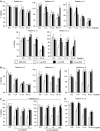Dexamethasone-induced cisplatin and gemcitabine resistance in lung carcinoma samples treated ex vivo
- PMID: 15756274
- PMCID: PMC2361940
- DOI: 10.1038/sj.bjc.6602453
Dexamethasone-induced cisplatin and gemcitabine resistance in lung carcinoma samples treated ex vivo
Erratum in
-
Correction to: Dexamethasone-induced cisplatin and gemcitabine resistance in lung carcinoma samples treated ex vivo.Br J Cancer. 2023 Oct;129(8):1363. doi: 10.1038/s41416-023-02433-5. Br J Cancer. 2023. PMID: 37723318 Free PMC article. No abstract available.
Abstract
Chemotherapy for lung cancer not only has severe side effects but frequently also exhibits limited, if any clinical effectiveness. Dexamethasone (DEX) and similar glucocorticoids (GCs) such as prednisone are often used in the clinical setting, for example, as cotreatment to prevent nausea and other symptoms. Clinical trials evaluating the impact of GCs on tumour control and patient survival of lung carcinoma have never been performed. Therefore, we isolated cancer cells from resected lung tumour specimens and treated them with cisplatin in the presence or absence of DEX. Cell number of viable and dead cells was evaluated by trypan blue exclusion and viability was measured by the MTT-assay. We found that DEX induced resistance toward cisplatin in all of 10 examined tumour samples. Similar results were found using gemcitabine as cytotoxic drug. Survival of drug-treated lung carcinoma cells in the presence of DEX was longlasting as examined 2 and 3 weeks after cisplatin treatment of a lung carcinoma cell line. These data corroborate recent in vitro and in vivo xenograft findings and rise additional concerns about the widespread combined use of DEX with antineoplastic drugs in the clinical management of patients with lung cancer.
Figures


Similar articles
-
Glucocorticoid-mediated inhibition of chemotherapy in ovarian carcinomas.Int J Oncol. 2006 Feb;28(2):551-8. Int J Oncol. 2006. PMID: 16391812
-
Dexamethasone reduces sensitivity to cisplatin by blunting p53-dependent cellular senescence in non-small cell lung cancer.PLoS One. 2012;7(12):e51821. doi: 10.1371/journal.pone.0051821. Epub 2012 Dec 18. PLoS One. 2012. PMID: 23272171 Free PMC article.
-
Involvement of MAPK phosphatase-1 in dexamethasone-induced chemoresistance in lung cancer.J Chemother. 2011 Aug;23(4):221-6. doi: 10.1179/joc.2011.23.4.221. J Chemother. 2011. PMID: 21803700
-
Influence of genetic markers on survival in non-small cell lung cancer.Drugs Today (Barc). 2003 Oct;39(10):775-86. doi: 10.1358/dot.2003.39.10.799471. Drugs Today (Barc). 2003. PMID: 14668933 Review.
-
Genetic testing for chemotherapy in non-small cell lung cancer.Lung Cancer. 2003 Aug;41 Suppl 1:S97-102. doi: 10.1016/s0169-5002(03)00151-x. Lung Cancer. 2003. PMID: 12867068 Review.
Cited by
-
Minireview: Familiar Faces in Unfamiliar Places: The Emerging Role of Nuclear Receptors in Lung Cancer.Mol Endocrinol. 2015 Dec;29(12):1675-83. doi: 10.1210/me.2015-1199. Epub 2015 Oct 20. Mol Endocrinol. 2015. PMID: 26484581 Free PMC article. Review.
-
Glucocorticoid receptor expression in 20 solid tumor types using immunohistochemistry assay.Cancer Manag Res. 2017 Mar 6;9:65-72. doi: 10.2147/CMAR.S124475. eCollection 2017. Cancer Manag Res. 2017. PMID: 28293120 Free PMC article.
-
Preclinical evaluation of pentagamavunone-1 as monotherapy and combination therapy for pancreatic cancer in multiple xenograft models.Sci Rep. 2022 Dec 27;12(1):22419. doi: 10.1038/s41598-022-26863-y. Sci Rep. 2022. PMID: 36575213 Free PMC article.
-
Glucocorticoid Receptor (GR) Expression in Human Tumors: A Tissue Microarray Study on More than 14,000 Tumors.Biomedicines. 2025 Jul 9;13(7):1683. doi: 10.3390/biomedicines13071683. Biomedicines. 2025. PMID: 40722755 Free PMC article.
-
Glucocorticoids suppress renal cell carcinoma progression by enhancing Na,K-ATPase beta-1 subunit expression.PLoS One. 2015 Apr 2;10(4):e0122442. doi: 10.1371/journal.pone.0122442. eCollection 2015. PLoS One. 2015. PMID: 25836370 Free PMC article.
References
-
- Aapro MS (1991) Present role of corticosteroids as antiemetics. In Recent Results in Cancer Research, Vol. 121, pp 91–100. Berlin: Springer Verlag - PubMed
-
- Bergman AM, Pinedo HM, Peters GJ (2001) Steroids affect collateral sensitivity to gemcitabine of multidrug-resistant human lung cancer cells. Eur J Pharmacol 416: 19–24 - PubMed
-
- Brady ME, Sartiano GP, Rosenblum SL, Zaglama NE, Bauguess CT (1987) The pharmacokinetics of single high doses of dexamethasone in cancer patients. Eur J Clin Pharmacol 32: 593–596 - PubMed
-
- Cancer Research UK (2004) Statistics and Prognosis for Lung Cancer. Cancer Research UK
-
- Cheng L, Du C, Murray D, Tong X, Zhang YA, Chen BP, Hawley RG (1997) A GFP reporter system to assess gene transfer and expression in human hematopoietic progenitor cells. Gene Ther 4: 1013–1022 - PubMed
MeSH terms
Substances
LinkOut - more resources
Full Text Sources
Medical

